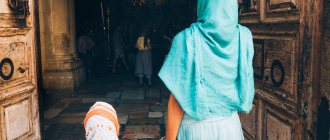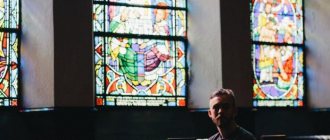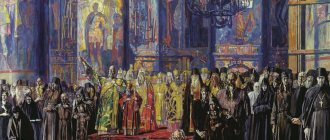In the Temple
Visiting the temple requires compliance with certain rules. The woman must wear a long skirt or dress. Long sleeves are recommended. Tracksuits and shorts are not allowed.
You need to enter the temple calmly and with reverence. In this case, the man takes off his headdress, and the woman, on the contrary, puts on a scarf.
If you did not expect to attend the service, but decided to go into the temple and found yourself dressed inappropriately, then in the vestibule of the temple, women can use a scarf and a skirt, worn over their existing clothes, while attending the service.
When you come to the temple to pray, wait a little, stand in reverent silence. Let peace come to your soul. It is better to come to the service in advance so that you have time to venerate the icons of those saints to whom you want to pray. When approaching the icon, cross yourself twice, kiss the bottom of the image and cross yourself a third time.
Loud talking and excessive gesticulation are not accepted in the temple.
It is customary to turn off mobile phones in church so as not to disrupt the course of the Divine Liturgy.
Orthodox Life
They don’t go to someone else’s monastery with their own rules. Archimandrite Markell (Pavuk), confessor of the Kyiv theological schools, strongly confirms this statement.
– Father, what is the correct way to greet monks and bishops?
– The Holy Apostle Paul, as well as the Hieromartyr Clement of Rome, compares Christians with warriors. The only difference between Christians and ordinary warriors is that the former fight not with people, but with the spirits of evil in high places, passions, flesh and the devil. And in war, like in war, there are victories and defeats. In order to more successfully and harmoniously wage invisible spiritual warfare, the Lord, back in the Old Testament, established an appropriate hierarchy of people serving God at the temple. A similar hierarchy continues in New Testament times. Wherever the apostles went to preach the Gospel, they ordained bishops, priests and deacons.
When a junior in rank approaches the commander, he salutes him in the manner established by military regulations. The military form of greeting a superior shows that a subordinate is ready to carry out his orders. Likewise, a Christian, when he approaches a priest or bishop, usually takes a blessing, folding his palms in a cross shape. This is both a form of greeting and a kind of sign that you trust this shepherd and are ready to humble yourself and fulfill the obediences he has entrusted to you. But most importantly, through the blessing of a priest or bishop, Christ Himself blesses us. A person’s reluctance to take a blessing may indicate distrust of the shepherd.
– Is it necessary to take a blessing when entering and leaving the monastery?
– In ancient times, in all monasteries, at the entrance there was a monk who was obedient to the goalkeeper (not to be confused with the goalkeeper during a football game). He stood at the monastery gates, let everyone entering and leaving the monastery kiss the cross and sprinkled it with holy water. Now such a tradition is preserved only in the monastery of St. Gerasim of Jordan in the Judean Desert. In ancient times, in our Pechersky Monastery, the Monk Longin, who lived at the turn of the 13th–14th centuries, became especially famous for this. Fulfilling this obedience, during his lifetime he acquired the glory of a visionary. He not only gave a blessing to everyone entering the monastery, but could also point out their most hidden and grave sins, since he was an excellent expert on human souls and could accurately discern in any person all his virtues and weaknesses.
Now, due to the large number of pilgrims, it is difficult to imagine a monk giving a blessing at the entrance to everyone, and even with spiritual guidance.
– Can everyone enter the monastery refectory? What are the rules of conduct?
“The most important thing for people to come to the monastery is to pray and repent of their sins. Meal is a pleasant continuation of prayer. Usually in monasteries there are special refectories for pilgrims, where they go with the blessing of the abbot of the monastery or the dean. On the territory of the Lavra we have both paid refectories, where you can dine for money, and free canteens for the poor, people in need of help.
Also, any pilgrim, if he remains in the monastery for a long period to carry out some kind of obedience, then eats and lives for free.
In the monastery refectory they try to talk less (unless something needs to be said urgently on business) and usually listen to the reading of the lives of saints, the spiritual teachings of the holy fathers of the Church, or say a prayer in their minds. In this way, it is possible to avoid the passion of idle talk and gluttony, that is, immoderate satiety of one’s belly, which interferes with prayer and work.
– What kind of clothing do secular people in the monastery wear?
– All monks in the monastery usually wear a black cassock and cassock, sometimes also a hood and mantle, thereby testifying to their renunciation of the world and all its temptations. When an ordinary person goes to a monastery, he also needs to try to dress decently and modestly. It is better for women not to wear trousers, but a long skirt, so as not to expose their legs. It is also advisable not to expose your arms and neck. As a rule, women wear a scarf on their heads. It is indecent for men to visit the monastery in sportswear, shorts and short sleeves. When entering the temple, men take off their headdress. On Sundays and holidays, when going not only to the monastery, but also to the parish church, it is advisable to dress in the best clothes in order to maintain a festive mood for yourself and other people.
– Who can I contact with questions of concern? Will the first monk you see really help?
– Issues of spiritual life are best discussed with monastery confessors, who have the blessing of the clergy for such conversations. As a rule, they confess people during the evening service or during the Liturgy before the Eucharistic canon. If it is not possible to attend a service, then at other times on the territory of the monastery you can ask the person on duty how to contact and talk with the priest. It is better not to talk to the first monk you come across, because not everyone can be competent to resolve complex issues of spiritual life. If you resort to such help recklessly, it can lead to serious problems.
We don’t consult the first person we meet or the nurse about our illness in the hospital. Everyone tries to get an appointment with a competent and competent doctor.
– Is it possible to use mobile phones on the territory of the monastery?
– Now this has become a serious problem, because many have almost become one with them. Of course, it is better to “put aside all worldly concerns” on the territory of the monastery. It’s better not to take your phone into a monastery, and especially a church, or at least turn it off, so that it doesn’t interfere with you and other people’s prayers. I also have a mobile phone, but I try to leave it at home when I go to church. It is better to always strive to be in touch with God through prayer than with other people, even if they are very important and necessary for us.
– Is it possible to take photographs or do I need to take permission for this?
– There is no strict prohibition on this, but if you want to take photographs during a service, then to do this you need to take a blessing from the dean of the monastery. If you have received such a blessing, stick to it. When during festive and especially bishop services there are many photo and video cameras that record almost every step of the clergy, this is very stressful and tiring for everyone. It would be good to issue a decree that photography in the church can only be taken before the litany “Catechumens, come forth,” and then, until the end of the service, to stop all photography and video recording, so as not to interfere with people’s prayers and not to develop the passions of pride and vanity in the clergy.
– Is it possible to enter churches outside of services or is this only permitted during services?
– Many monastery churches are always open, and therefore you can come here and pray not only during divine services, but also at any other time. Except that at night all the churches are closed. But it is better to be in church during the service, since conciliar prayer led by a priest is much more attentive, focused and powerful. In church, we all, even without fully realizing it, pray for each other and thus support each other. It is not for nothing that St. John Chrysostom asserted: “One “Lord have mercy,” said in church, is more effective than a thousand bows made at home.”
– Is it necessary to make a bow at the entrance to the monastery?
– Not only when entering the monastery, but also before venerating icons and relics, while standing in prayer, you should try to bow at the waist or even bow to the ground. They also help you better concentrate on prayer. And when the body remains idle during prayer, then the mind involuntarily begins to dissipate and standing in the temple becomes unbearably difficult. Some even very young people are just looking for somewhere in the temple to sit down. This occurs due to the fact that the body is not accustomed to prayer work. But the holy fathers of the Church noted that prayer in which the body has not worked is an unripe fruit. Prostrations to the ground are not made only during the period from Easter to Pentecost as a sign that we are no longer slaves of the evil one and sin, but free people, since the Lord atoned and forgave all our sins on the Cross. Now we must try, with God’s help, not to repeat them again.
– Is it necessary to light candles and buy monastery products?
– Usually everyone tries to do this, although there is no rule. It's not obligatory. However, every candle we light is our small sacrifice to God. It is important to do it with all your heart, with prayer and heartfelt repentance for your sins, otherwise it will not bring us any benefit, for the best sacrifice to the Creator, as we read in Psalm 51, is a broken spirit. When purchasing monastery products, we also make a certain donation to the monastery. The proceeds from sales go towards the repair and restoration of churches, payment of utilities, wages to workers, clothing and food for the monastery brethren, educational and social projects. Believe me, they do not go anywhere abroad, to any foreign religious centers, especially to Moscow, as our ill-wishers slander.
Interviewed by Natalya Goroshkova
At the monastery
When arriving at a monastery, you must remember that the goal of monastic life is prayerful concentration, therefore you must behave modestly, quietly, attentively, without violating the monastic way of life.
Pilgrims must strictly observe the internal regulations established in the monastery: leaving the hotel at night is not allowed without a blessing, and prayerful silence must also be observed.
The territory of the Holy Kazan Women's Monastery is open to visitors from 6 a.m.
At 22:00 the monastery gates are locked for the night.
An exception is made only for night services on great holidays, Christmas and Easter.
From the book of Aristarkh (Lokhanov), abbot “What you need to know about Orthodox church etiquette”:
The monastery has stricter discipline than the parish. And although there are mistakes
newcomers are usually forgiven and covered with love; it is advisable to go to the monastery, already knowing the rudiments of the monastery rules.
The convent is governed by the abbess.
Due to the need for a clearly organized monastic life (and monasticism is a spiritual path, so verified and polished by centuries of practice that it can be called academic), everyone in the monastery bears a certain obedience.
The first assistant and deputy governor is the dean. He is in charge of all worship services and the fulfillment of statutory requirements. It is to him that people usually refer regarding the accommodation of pilgrims coming to the monastery.
Special rules for women
These rules apply to the period of female impurity. On critical days, most women themselves try not to visit the temple, but church rules do not prohibit them from participating in divine services if they remain in the narthex (the narthex is a special room between the front door and the central part of the temple). You can pray, but it is forbidden to venerate shrines and, most importantly, to take communion and take part in other church Sacraments. This rule should not be considered discrimination against women. According to church canons, in church during communion we eat the Body and Blood of Christ, so there should be no human blood here. Not only a woman, but also any priest, if he has a bleeding wound, has no right not only to enter the altar, but also into the temple itself.
About monastic rules
The monastery is a special world. And it takes time to learn the rules of monastic life. When you come to the monastery as a pilgrim or worker, remember that in the monastery they ask for a blessing for everything and strictly fulfill it.
- You cannot leave the monastery without a blessing.
- They leave all their sinful habits and addictions (wine, tobacco, foul language, etc.) outside the monastery.
- Conversations are only about spiritual things, they do not remember about worldly life, they do not teach each other, but they know only two words - “forgive” and “bless”.
- Without grumbling, they are content with food, clothing, and sleeping conditions.
- They do not go to other people’s cells, except when they are sent by the abbot. At the entrance to the cell they say aloud a prayer: “Through the prayers of the saints, our fathers, Lord Jesus Christ, Son of God, have mercy on us.”
- They do not enter the cell until they hear from behind the door: “Amen.”
- They avoid free speech, laughter, and jokes.
- When working on obediences, they try to spare the weak person who works nearby, covering with love the errors in his work.
- When meeting each other, they greet each other with bows, the younger greets the older with the words: “Bless”; and the other responds to this: “God bless.”
- When sitting down at the table in the refectory, they observe the order of precedence. The prayer said by the person serving the food is answered “Amen”, the table is silent and listens to the reading.
- They are not late for divine services, unless they are busy with obedience.
- Insults encountered during general obediences are endured humbly, thereby gaining experience in spiritual life and love for the brethren.
On the territory of the monastery
Free entry is allowed only into the temple (subject to the rules). You can walk around the territory of the monastery only with a blessing and, as a rule, with a monastic escort. Entry into the residential and business premises of the monastery is prohibited.
It is unacceptable to: make noise, talk loudly and laugh, smoke, drink alcohol or drugs and be intoxicated on the territory of the monastery, use loud-speaking equipment, play musical instruments, use obscene language, have obscene conversations, spit and litter, enter the territory monastery with animals, take video and photographs without blessing, conduct conversations with nuns and students of the monastery; behave disrespectfully and violate prescribed rules of behavior.
During the entire stay in the monastery, the sound in mobile phones must be turned off.
General rules for visiting churches.
- Before entering a church (temple), turn off your mobile phone. It can interfere with prayer or church services.
- When entering the church, men must remove their hats.
- In church, try not to stand or turn your back to the altar.
- Do not leave children unattended, explain to them the need to be quiet. If a child is crying and cannot be calmed down, leave the temple with him.
- If you are attending a service, men should stand on the right side of the church and women on the left.
Photo and film shooting in churches and monasteries.
- When visiting a monastery or church, first of all, inquire about the rules of filming in that particular location. Your unceremonious actions may disrupt worship or interfere with the prayer of believers.
- Do not take photographs during services or film monks.
- Do not use flash in churches! This damages ancient frescoes and icons.
And to everyone who holds a camera in their hands, I wish good weather, beautiful clouds and successful shots!
Spaso-Yakovlevsky Dimitriev Monastery.
Rostov. to the top










